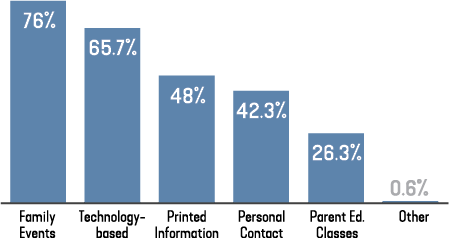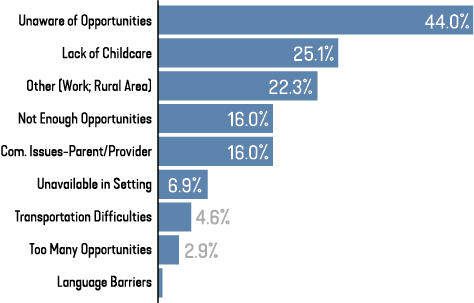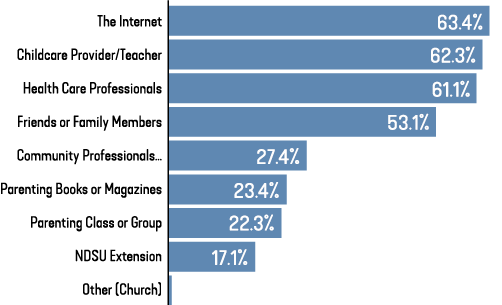Family Engagement in Early Childhood Settings in North Dakota: Opportunities, Barriers and Parent Preferences (Executive Summary) (FS2002, Dec. 2020)
Contents
Purpose
Acknowledgments
Summary of Key Findings
Section One: Family Engagement in Early Childhood Settings – A Summary of Focus Group Themes
Section Two: Parent Feedback Survey on Family Engagement
Conclusion
Purpose
The goal of this project, which was undertaken to fulfill objectives associated with the Preschool Development Grant Birth to Five (PDG B-5) federal grant, was to expand understanding of and opportunities related to family engagement in early childhood settings in North Dakota. In 2019-20, multiple focus groups consisting of early childhood professionals and parents were conducted to gain a better understanding of current family engagement opportunities in North Dakota. Participants were a mix of parents and early childhood professionals and included 18 females and one male from Dickinson (six), Fargo (nine), and Minot (four). Further, a parent feedback survey was employed to gather additional information on family engagement, with 175 parents of children ages 0 to 5 and early childhood professionals completing the survey.
Early childhood education programs and resources potentially can provide enormous benefits to a young child’s development during the rapid period of growth from birth to 5 years old. Family engagement opportunities with early childhood professionals or other community resources are important because these activities enhance and promote building the collaborative mindset required for a child’s optimal development.
Acknowledgments
Collaboration among the state of North Dakota, NDSU Extension and North Dakota Parent Education Network made this project and study possible. We thank the North Dakota Department of Public Instruction for allowing us the opportunity to aid in conducting research on this pertinent topic.
Work on this project was conducted in association with ND DPI Contract #3485, a subcontract extended to NDSU Extension as part of a competitive federal grant received by North Dakota in 2019 to focus on improvements to the state’s existing early childhood infrastructure and resources. Additionally, we extend our thanks to the early childhood professionals and parents who participated in this study. Their insight and perspective on the topic of family engagement and related activities provided valuable contributions regarding the available opportunities, barriers and preferences in North Dakota. With this study and report, we aspire to enhance the lives of families with young children in North Dakota.
Summary of Key Findings
- Participants had limited knowledge of available resources and family engagement opportunities.
- Various context-specific barriers created difficulties for families, reducing overall involvement in family engagement activities.
- A range of preferences regarding resources and opportunities for family engagement were reported by participants.
Listed below are the key points that were identified through thematic analysis of the focus group discussions, as well as data analysis from the parent feedback survey on family engagement:
- A variety of family engagement opportunities in early childhood settings are available in North Dakota. Contexts for activities include community-based options, professional community organizations, informal community connections and formal education options.
- Parent preferences related to means of contact for family engagement opportunities vary. A majority of participants indicated they would like to be informed via technology options, mailing/printed information, phone calls and individual contact, and through group settings.
- Strategies for increasing family engagement in North Dakota include utilizing a specific community resource as a mechanism for family engagement, facilitating parent-to-parent connections, creating consistent family engagement opportunities, utilizing a transition experience (for example, transition to kindergarten) as a way to engage families, and increasing the amount of family engagement activities offered in the formal education setting.
- Common challenges that families in North Dakota face that decrease their involvement in family engagement activities often fall within the realm of Attitudes, Awareness, Availability and Access. Although what is important to note is that these challenges vary by family and community.
- North Dakota families preferred human connection options for family engagement opportunities, followed by digital and community options.
- Professional barriers also decrease family engagement opportunities in North Dakota. Typically, these professional barriers include Awareness, Professional Development and Support and Policy Issues, which limit or complicate opportunities.
“Family engagement is an interactive process through which program staff and families, family members and their children build positive and goal-oriented relationships. It is a shared responsibility of families and professionals that requires mutual respect for the roles and strengths each has to offer. Family engagement means doing with — not doing to or for — families.” (Head Start Parent, Family and Community Engagement (PFCE) Framework, 2011)
Section One: Family Engagement in Early Childhood Settings – A Summary of Focus Group Themes
The themes here emerged from an analysis of the feedback provided by participants in focus groups on the topic of family engagement in early childhood settings in North Dakota.
Topic One
Opportunities for Supporting Family Engagement in Early Childhood Settings in North Dakota
Key Finding – Family members with young children and early childhood professionals highlight a range of meaningful opportunities for family engagement with children ages birth to 5 across multiple communities in North Dakota. Supportive settings for family engagement include community-based options, family and community support organizations, and formal educational options. Options suggested are in Table 1.
Table 1: Supportive Options for Family Engagement With Children Ages 0 to 5.
|
Community-based Options |
||
|
Children’s drama or theater groups |
City parks and recreation programs |
Faith-linked parent groups |
|
Fitness or recreation centers, programs |
Local art centers, museums, zoos |
Informal networks of family, friends |
|
Music education programs |
Preschool programs |
Public library |
|
Family and Community Support Organizations |
||
|
Counseling centers |
Early intervention services |
Early Head Start or Head Start programs |
|
Home visiting programs |
Hospital or health-care systems |
Pregnancy and parenthood support services |
|
Formal Educational Options |
||
|
Family-based or center-based child care/preschool |
Early Head Start or Head Start |
Public or private schools (elementary) |
Topic Two
Preferred Strategies for Family Contact in North Dakota
Key Finding – Family members with young children and early childhood professionals describe a range of preferred contact strategies for pursuing family engagement, ranging from usage of technology options to phone calls to in-person visits and meetings. Suggested options are in Table 2.
Table 2: Preferred Strategies for Family Contact in North Dakota.
|
Technology |
Direct Contact – |
Direct Contact – |
Direct Contact – |
|
• Texting • Private social media groups (Facebook, etc.) • Apps (SeeSaw, BrightWheel, etc.) |
• Mailed information or printed information • Family engagement calendar (specific times, dates and activities listed) • Phone call |
• Make a home visit • Make a personal connection (when child is dropped off, etc.) • Face-to-face contact • Parent conference or parent-provider meeting • Invite parent outreach • Personal request • Expand to multiple family members (grandparent, etc.) |
• Group contact (monthly parent meeting, etc.) • Parent network (facilitate parent sharing, connections, etc.) |
Topic Three
Strategies for Family Engagement in Early Childhood Settings
Key Finding – Family members with young children and early childhood professionals describe a large variety of strategies for facilitating engagement in early childhood settings. Key suggestions are listed in Table 3.
Table 3: Strategies for Family Engagement in Early Childhood Settings.
|
Suggested Family Engagement Strategies |
Examples |
|
1) Provide an introduction or set up a linkage to a specific community resource as a mechanism for family engagement. |
• Network with others, link families to resources • Share information on resources or opportunities in a clear, easy location – brochures, calendars, etc. • Invite other organizations to share about resources |
|
2) Facilitate parent-to-parent connections so they can share information, link to resources and build support networks. |
• Support a “buddy system” for sharing information, reminders • Encourage parents to connect with other families • Support play groups, parent discussion groups, etc. |
|
3) Furnish a consistent opportunity for parents to gather, meet and increase knowledge, skills and connections to others or sources of support. |
• Offer family meetings, activities to socialize • Furnish educational classes to parents, children • Provide parent discussion, support groups for selected audiences or specific topics of interest |
|
4) Utilize a transition experience (for example, transition to kindergarten) to engage children and families in a systematic way and ease the transition. |
• Provide an orientation session to the transition setting or experience • Invite children and families to visit, get familiar • Continue opportunities for family contact with staff, program after the transition |
|
5) Utilize formal educational settings to offer specific opportunities for family engagement, such as helping in the classroom or being on a committee. |
• Connect with parents as they come to a location • Use simple procedures for contact, communication • Offer regular chances to help with class activities • Engage parents in supporting learning activities |
Topic Four
Challenges to Family Engagement in Early Childhood Settings
Key Finding – Families may experience challenges that limit opportunities for family engagement due to issues of attitude, awareness, availability and access to community options. Also, specific family-linked or community-linked challenges may limit engagement. See examples in Tables 4 and 5.
Table 4: Consistent Obstacles to Family Engagement in Early Childhood Settings.
|
Attitude |
Availability |
|
Awareness |
Access |
Table 5: Family and Community Obstacles to Family Engagement in Early Childhood Settings.
|
Family-linked Challenges • Individual, family background challenges or health issues (mental health, chemical issues, etc.) • Conflict with busy work schedules • Economic or resource barriers (transportation, money, technology access, etc.) • Difficulty in managing time commitment |
Community-linked Challenges • Limited English language abilities, supports • Limitations in child-care system, shortage of openings, challenges with staffing resources • Shortage of staff resources to provide key supports in areas such as special health-care needs • Time or distance involved in reaching available supports |
Topic Five
Preferred Resources and Opportunities for Family Engagement in Early Childhood Settings
Key Finding – Family members with young children and early childhood professionals indicate preferences for family engagement through: (1) personal connections with others, (2) digital connections and (3) community connections with established providers in the ECE community. Key points and examples are in Table 6.
Table 6: Preferred Resources and Opportunities for Family Engagement.
|
Personal Connections |
Digital Connections |
Community Connections |
|
• The most critical resource or strategy to enhance family engagement is making personal connections and building relationships between parents and community professionals or providers. • The most likely source of information that individuals turn to first for learning about family engagement opportunities are their personal connections, meaning their family members, friends and parents with children of a similar age. |
• The usage of the internet or digital technologies in relation to family engagement primarily was mentioned as a contact mechanism, a resource for information or for sharing information with others. • Social media usage – share reminders, child activities • “Electronic backpack” Online Sources • Attendance Works • Center on the Social and Emotional Foundations of Learning (CSEFEL) • Early Childhood Learning and Knowledge Center (ECLKC) • NAEYC • Zero to Three |
• The network of community providers can facilitate awareness, engagement and links to resources. Health-care Providers • Health-care staff (nurses, public health, etc.) • Women, Infants, Children program (WIC) • ND Health Tracks Program Early Intervention Providers • ND Early Intervention Services • Right Track Program • Family Voices of ND • Community providers Educational Providers • Teachers, child-care providers, school staff • Early Childhood Special Education • Early Head Start/Head Start • NDSU Extension |
Section Two: Parent Feedback Survey on Family Engagement
The purpose of this parent feedback survey on family engagement was to focus on increased understanding about family engagement in early childhood settings in North Dakota. Study participants were parents or caregivers of children between the ages of birth and 5 years of age in North Dakota, as well as early childhood professionals in the state.
In North Dakota, a total of 175 participants completed the survey via Qualtrics in early 2020. Three key questions were asked of participants that elicited information on their views related to family engagement in early childhood settings.
Family Engagement Preferences
The first topic explored was preferred family engagement options relative to involvement with a child’s early care and education. The most highly preferred options were family events (play groups, family nights, etc.), technology-based options (texting, email contact, online support groups, etc.), printed information or personal contacts such as home visits or parent-teacher conferences (see Table 7).
Table 7: Preferred Family Engagement Options for Parents of 0-5 Children.

Barriers to Family Engagement
The second topic explored was barriers that may limit family engagement in a child’s early years. The most noted barriers were lack of awareness of engagement opportunities, limited child care availability when needed, other obstacles, no or limited options for parent involvement, and lack of communication between parents and providers (see Table 8).
Table 8: Barriers to Family Engagement for Parents of 0-5 Children.

Family Engagement Sources
The third topic explored was the preferred sources of information that parents and caregivers rely on for information related to family engagement. The most preferred sources of information were the internet, child-care provider or teacher, health-care professionals (nurse, pediatrician, etc.), and family members or friends (see Table 9). A few additional sources also were identified as supportive information sources.
Table 9: Preferred Family Engagement Information Sources for Parents of 0-5 Children.

Conclusion
The information included in this executive summary provides a useful variety of feedback from parents and early childhood professionals regarding the topic of family engagement in North Dakota. We are grateful to those who participated in providing this information and also to those who reviewed it. Our hope is that parents, early childhood professionals and other stakeholders will find useful information for consideration in exploring issues and needs related to the topic of family engagement in North Dakota.

